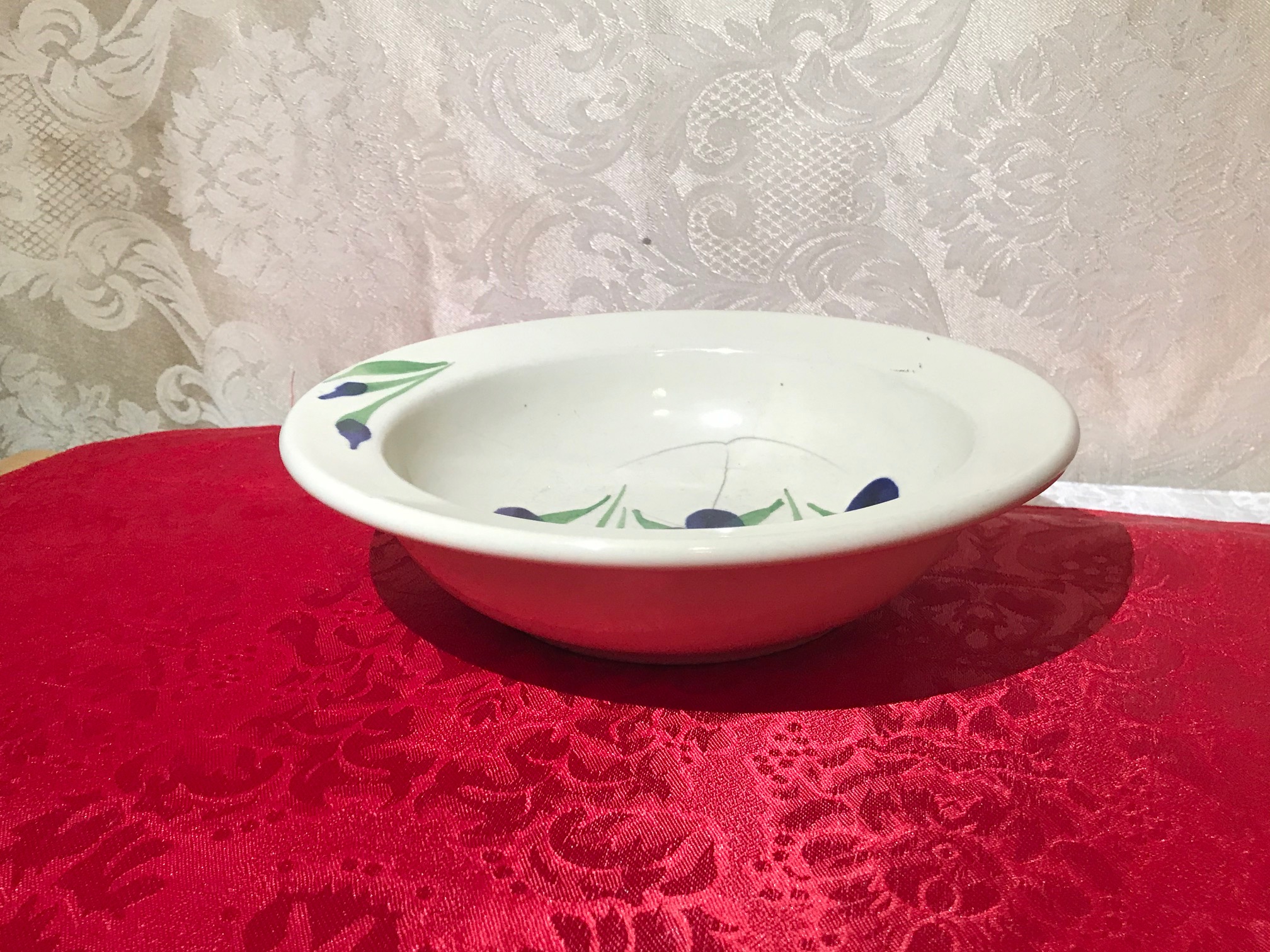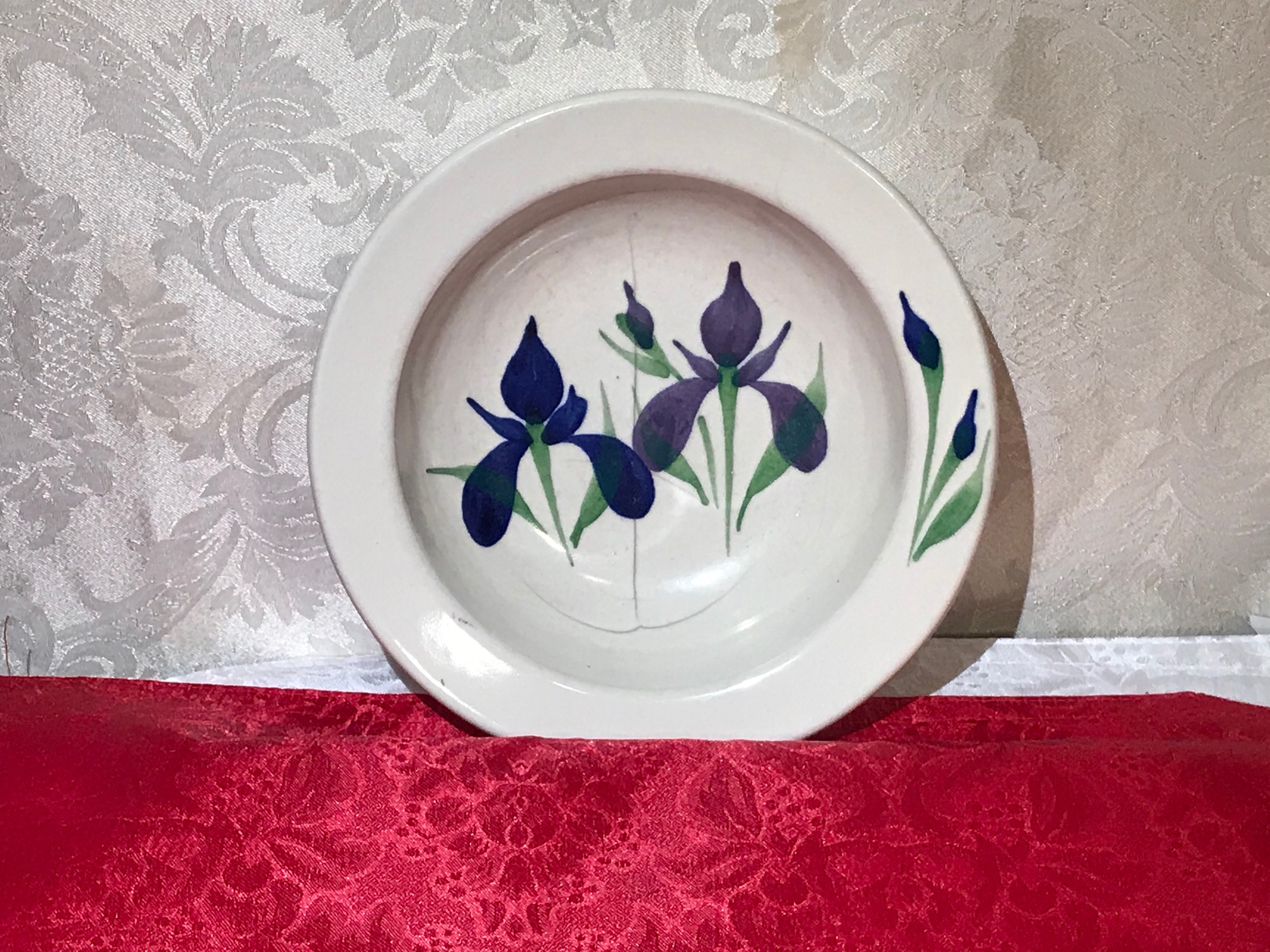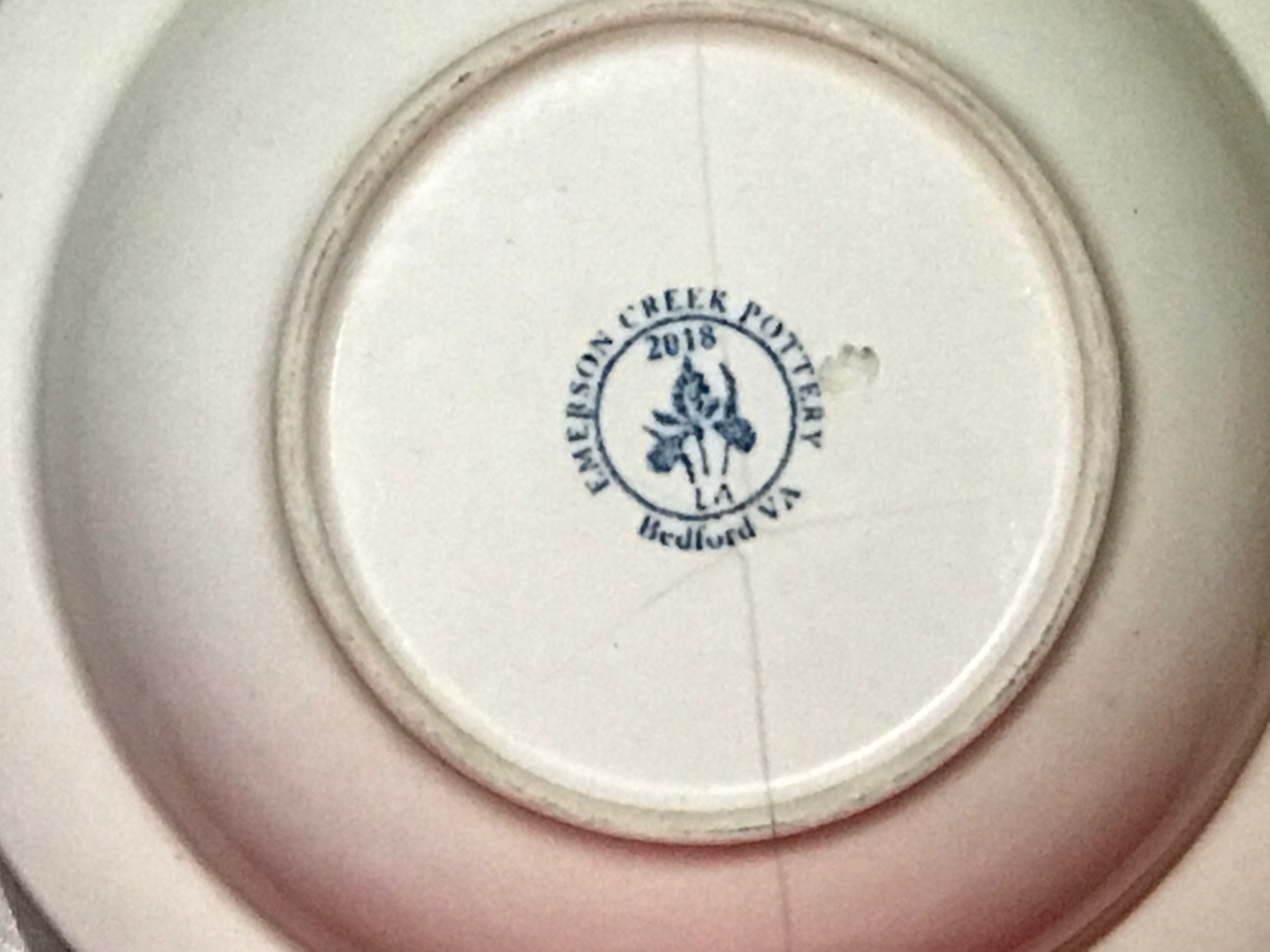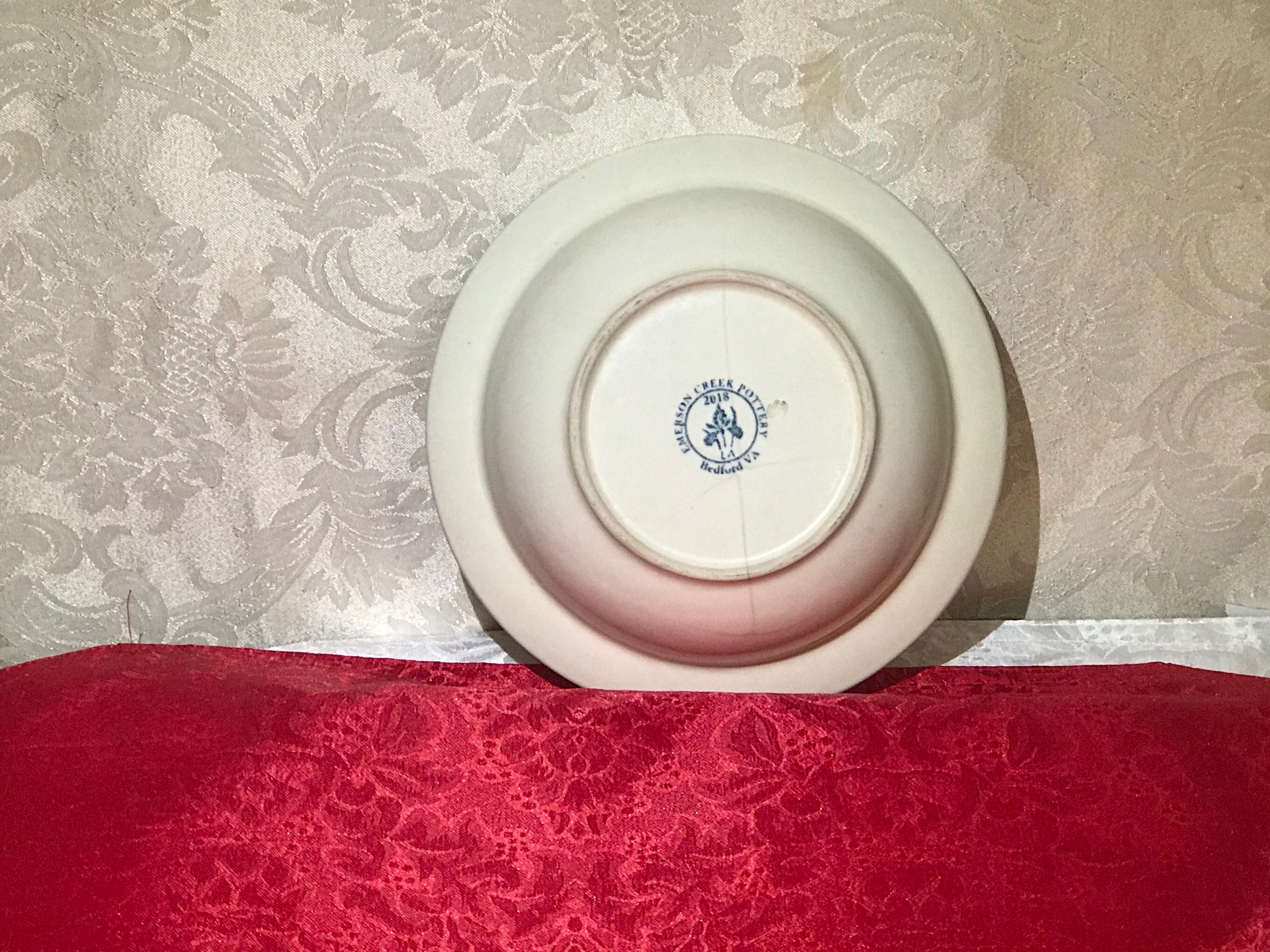2018 Emerson Creek Pottery Bowl: Lead-free food surface glaze & 17 ppm Lead in the substrate. Advertised as Lead-free.

Introduction (for those new to this website):
Tamara Rubin is an independent advocate for consumer goods safety. She is also a mother of Lead-poisoned children. She began testing consumer goods for toxicants in 2009 and was the parent-advocate responsible for finding Lead in the popular fidget spinner toys in 2017. Tamara uses XRF testing (a scientific method used by the U.S. Consumer Product Safety Commission) to test consumer goods for metallic toxicants, including Lead, Cadmium, Mercury and Arsenic.
Wait, I thought Emerson Creek Pottery was Lead-free?
Well… it’s almost Lead-free – but not quite. The amount of Lead found in the ceramic substrate of this bowl from Emerson Creek Pottery would be considered safe by all standards; however, I would not classify this piece as “Lead-free” — as precision XRF testing did clearly and consistently show it has a trace amount of Lead content.
With all examples of Emerson Creek Pottery that I have tested to date (across multiple years of manufacture), the glazes appear to be consistently Lead-free – and, as a result, there is not likely any leaching hazard concern with their products. “Non-Leaching” is what pottery studios normally mean when they erroneously use the term “Lead-free” (as appears to have historically been the case with Emerson Creek Pottery).
What is a “trace” amount of Lead?
A “trace” amount means a very low level [in this context, say, an XRF spectrometer instrument reading of single- to double-digits parts per million]. Trace amounts of Lead are often (but not always) found in the base substrate (the unglazed clay/ceramic) of pottery pieces – whether handmade or mass-manufactured. When Lead is found at levels in this range, it is not likely there as an intentionally–added ingredient, but is more-often-than-not a low-level contaminant of the base clay. If glazed with Lead-free glaze, these trace levels of Lead often found in ceramic substrates are not likely to pose any sort of health risk to the end user of a ceramic product (bowl, plate, mug) — especially with an item that is “high-fired” ceramic, as these pieces from Emerson Creek appear to be.
Here are the exact XRF test results for the Emerson Creek Pottery Iris pattern glazed ceramic bowl pictured on this blog post.
Food Surface of Bowl (test #1):
- Chromium (Cr): 321 +/- 70 ppm
- Tin (Sn): 1,349 +/- 59 ppm
- Zinc (Zn): 1,456 +/- 94 ppm
- Copper (Cu): 210 +/- 51 ppm
- Iron (Fe): 839 +/- 184 ppm
- Vanadium (V): 91 +/- 24 ppm
- Titanium (Ti): 382 +/- 48 ppm
- Zirconium (Zr): 10,300 +/- 300 ppm
- Cobalt (Co): 2,258 +/- 197 ppm
Food Surface of Bowl (test #2):
Focus on blue of irises…
- Chromium (Cr): 7,258 +/- 262 ppm
- Zinc (Zn): 6,135 +/- 246 ppm
- Copper (Cu): 287 +/- 57 ppm
- Iron (Fe): 858 +/- 181 ppm
- Vanadium (V): 265 +/- 39 ppm
- Titanium (Ti): 413 +/- 56 ppm
- Zirconium (Zr): 10,900 +/- 300 ppm
- Cobalt (Co): 12,500 +/- 500 ppm
Logo Area, Back of Bowl:
- Lead (Pb): 27 +/- 13 ppm*
- [Second reading for Lead – 90 seconds: 19 +/- 9 ppm]
- Chromium (Cr): 902 +/- 74 ppm
- Copper (Cu): 170 +/- 42 ppm
- Iron (Fe): 912 +/- 165 ppm
- Vanadium (V): 86 +/- 21 ppm
- Titanium (Ti): 268 +/- 36 ppm
- Zirconium (Zr): 8,318 +/- 219 ppm
- Platinum (Pt): 130 +/- 44 ppm
- Cobalt (Co): 1,534 +/- 149 ppm
- *This area of glaze is thinner than the glaze on the food surface and this reading is likely a reading through the glaze to the substrate below.
Unglazed Ceramic Rim on Back of Bowl:
90-second test
- Lead (Pb): 17 +/- 7 ppm
- [Second reading for Lead – 180 seconds: 18 +/- 6 ppm]
- Zinc (Zn): 44 +/- 12 ppm
- Copper (Cu): 45 +/- 22 ppm
- Iron (Fe): 2,665 +/- 162 ppm
- Vanadium (V): 121 +/- 26 ppm
- Titanium (Ti): 1,703 +/- 83 ppm
- Zirconium (Zr): 1,794 +/- 35 ppm
XRF testing was done for a minimum of 60 seconds per component (unless otherwise noted), and repeated multiple times to confirm the results. Results are science based, accurate, and replicable.
How much Lead is “too much” Lead?
The amount of Lead that is considered unsafe (and illegal) in a modern / newly-manufactured item made and sold as “intended for use by children” today is anything 90 ppm Lead or higher in the paint / glaze or coating and anything 100 ppm Lead or higher in the substrate. Ceramic dishes are not covered by this regulatory standard (even though it is my opinion that they should be – because children obviously use dishes!) Regardless of the lack of regulations for dishes [= absurd loophole], this dish would be be considered clearly safe by all current standards (including the standard for items “intended for use by children”).
Is truly “Lead-free” pottery possible? Yes!
To reiterate: many potteries advertise their ceramics as being “Lead-free” when these products should be more accurately described as “Lead-safe”, or “non-leaching”. Modern functional pottery made today must (at the time of manufacture) be “non-leaching” (specifically for Lead) to comply with current FDA regulatory standards.
Relevant Considerations
- To meet this leach-testing requirement, most small U.S.-based pottery studios intentionally use Lead-free glaze over what is normally a fairly low-Lead substrate.
- The glaze effectively encapsulates any Lead that is in the substrate, so that it does not have the potential to leach.
- Since leach-testing is required by the FDA – upon request by a customer a pottery studio should be able to provide customers with independent laboratory leach-testing results documentation demonstrating that their products meet or exceed the current Federal requirements limiting leachable Lead.
- However, it is important to note that most potteries do not have access to expensive high-precision XRF spectrometry analysis of their finished products for measuring total Lead content (which is simply a precise atomic measurement, expressed in parts per million – of any actual Lead that is present in the item.)
- XRF test results are completely distinct from a measurement obtained via a leach-testing of that same ceramic dish, bowl or cup. A ceramic item can pass “leach testing” (effectively confirming it is not leaching Lead above the threshold of detection of the test) yet still test positive for Lead using XRF instrumentation.
- Some ceramics manufacturers have attempted (in their literature online) to diminish the validity of XRF testing for testing ceramics, however XRF testing is a completely valid tool when looking specifically to determine total Lead content (vs. leachable Lead.)
The only handcrafted pottery brand that I have done detailed testing on so far which I found to consistently have both a Lead-free glaze AND a Lead-free substrate (at least in the limited number of items I have tested from that brand so far) is Bennington Potters of Vermont (you can see an example of one of their pieces at this link here.) That said, there are some other individual examples of both factory-made and hand-made ceramics that I have tested that have also been completely Lead-free; this “Set Mug” from the Ellen Show is a good example – link.
In addition to the two mugs linked in the above paragraph, to reinforce the fact that creating truly Lead-free items is possible – here is a list with five more examples of truly Lead-free ceramic pieces that I have tested and written about here on the blog:
- Lead-free ceramic tile (glaze and substrate were tested)
- Lead-free terra cotta oil lamp (unglazed)
- Lead-free Crate & Barrel bowl (glaze and substrate were tested)
- Lead-free ceramic mixing bowl (glaze and substrate were tested)
- Lead-free unglazed terra cotta bean pot
As always, thank you for reading and for sharing my posts.
Please let me know if you have any questions.
Tamara Rubin
#LeadSafeMama

Never Miss an Important Article Again!
Join our Email List





Hello,
Thank you for sharing all that you do for other people to be more informed! We are currently going through our kitchen and replacing our vintage Corelle with the plain white and I was wondering if you have tested or would test Polish pottery for reference? I’d love to have our own XRF, but that’s not in this military family’s budget. We have Polish pottery mugs from being stationed in Germany and they’re beautiful, but if found dangerous… I’ll gladly replace for my family’s safety.
Thank you and God bless you & your family! Keep up the good work, please and thank you!
Hello Tamara!
I am so impressed by all you do for your family and for all of our families as well! You seem to be an authentic American Hero!! Thank you!!!
I am a bit overwhelmed with all the information on your site, & apologize if I ask an already answered question. I had resigned myself to fact that white/glass dishes were the only safe (& beautiful) choices.
Came across Bennington pottery adds, & then a post about a mug you tested which was lead safe/free (February 2020). I am very interested in the MORNING GLORY, ELEMENTS BLUE, & BLUE AGATE GLAZES, & the PLATES & BOWLS SUBSTRATES. Do you have any new information on this pottery? I’m so excited that their might be additional safe & beautiful choices!!
No matter what, I wish you & your family the very happiest & healthiest holiday season!!
God bless you & your work,
Barbara Faries
I have an old Limoge Rees teapot in all white with gold trim which is in the Louise Phillipe style. It datesback to the 1800’s and is the white porcelain. Do you know anything about the lead content in the all white French Limoge pieces? I have been going through our kitchen cabinets purging anything that may contain harmful levels of lead. My husband LOVES this teapot. But I cannot any information on the content of this particilar type of REES LIMOGE teapot!
I would test it if I knew how to do so thoroughly. Thank you for any information you may have!